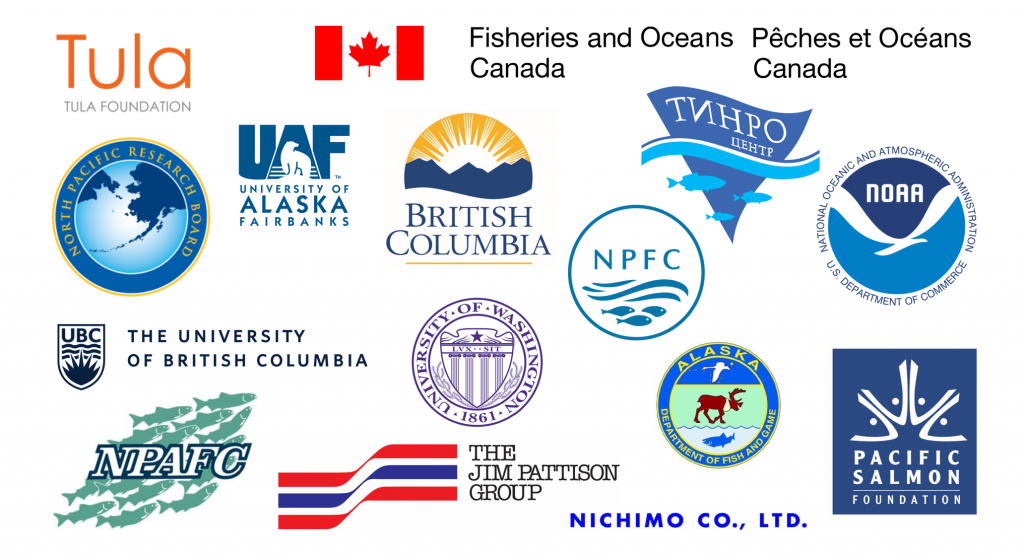Raw Spirit
Eric Sorensen
Overview
The Raw Spirit was built in 1998 in Harstad, Norway and designed by naval architects Atalantconsult A/S. The Raw Spirit (then Nordfjordtral) was originally built to fish groundfish — primarily cod in the Barents and North Sea and shrimp off the coast of eastern Greenland. She performed admirably in these fisheries gaining a reputation among North Atlantic fishermen as one of the finest sea-keeping vessels in her size class.
In 2013 the vessel was sold by the Norwegian company Aker Seafoods AS to the newly formed Independent Seafood Canada Corp (ISCC). After acquisition by ISCC she sailed to Akuari, Iceland for retrofitting to be able to fish in the Canadian west coast fisheries for Pacific whiting, walleye pollock and arrowtooth flounder. This retrofit included extensive modernization of bridge electronics, fish finding technologies and a refrigeration system, as well as a complete rebuilding of the fish-room to be able to store up to 70 metric tonnes of product per 24 hours in horizontal freezers.
Since arrival in Canada, she has proved herself to be one of the highest producing fishing vessels in the country. To this day she continues to operate reliably, safely, and economically in our west coast fisheries, receiving many more updates and upgrades on an ongoing basis. Presently the Raw Spirit is registered at 931 GT, 43.5 m LOA and can accommodate a maximum of 28 crew.
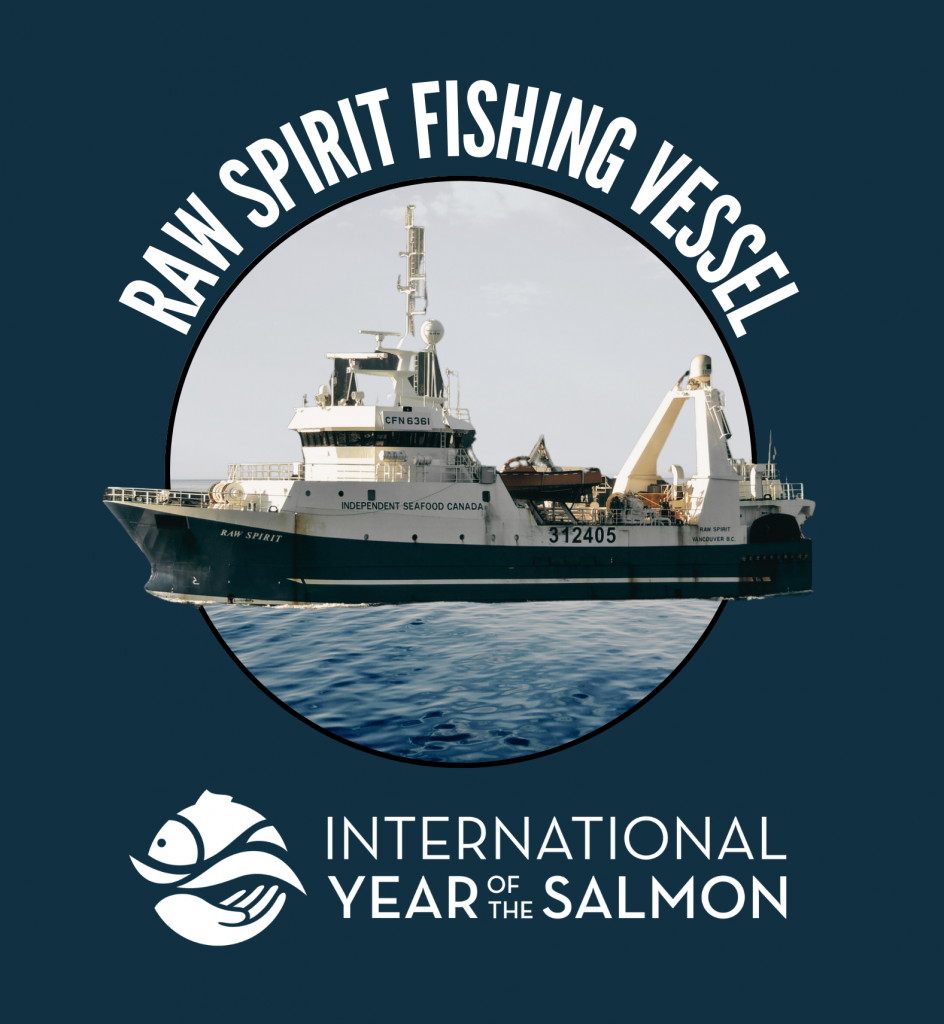
UPDATES FROM THE SHIP
Click on photo gallery to enlarge images!
The Raw Spirit has spent the first 10 days of fishing sampling the southern part of the study area. The focus was to sample stations that had been fished at night by the Sir John Franklin. Additionally we fished south of 47N as was planned pre survey. The weather prevented fishing on transect 141 O W but we are hopeful we will pick up some of these stations on our second leg of survey.
We fish a combination of gillnets and longlines each night with up to three sets in the water at any given time. Gear is all working well in fair seas and we are quickly learning what we can and cannot successfully fish in. In addition to the fishing we are conducting CTD and bongo at each station and eDNA is also collected.
To date the most abundant salmon have been Coho and Sockeye with 48 and 45 caught in the first 10 stations. Sockeye were predominantly north of 48 O N whereas Coho were predominantly south of 47O N. Coho are more commonly encountered and have been caught in 8 of the 10 stations fished.
The catch of chum salmon has been lower than expected with 19 caught to date. These have been encountered in small numbers throughout the survey and the majority of them are first ocean winter fish. We have caught only 9 pink salmon to date. In the previous surveys (2019 and 2020) chum and pink salmon were more abundant in daytime sets. We will therefore make time for some daytime fishing in coming days.
The catch of steelhead has been consistent with fish encountered in 8 of the 10 stations sampled and a total of 29 steelhead caught.
Other species encountered include Black Rockfish, Dogfish, longnose lancetfish, Salmon sharks (non have been landed) and squid (O. borealjaponica).
We will be headed in for fuel this weekend ahead of a nasty low that is approaching. Next week we will start sampling the northern portion of the study area.
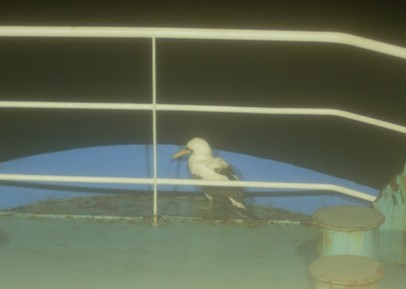

You never know what you will see when you go to sea. Sometimes it may be the last thing you expected to see. We had one of those experiences the second night into our survey. It was about 7pm. The weather was nasty. The wind was blowing 40 kts. Seas were 4-5m. Captain Hans Jassen was on the bridge. He observed something large flying around and around the ship. Curious to what it was, he turned on the flood lights on the bow. A large bird landed just ahead of the railing of the ship. Iy was large, about two feet high. Its beak at least 8 inches long. The bird settled in, tucking its head under its wing, ready for some refuge from the storm. Rebecca LaForge, a science team member on the Raw Spirit and an avid birder was called to help identify the bird. Rebecca called in friends in the birding community to help identify some pictures. The pictures were through a salty rain covered window with a ships light the only illumination, so as expected, they are not super sharp. However, the bird appears to be either a Masked or Nazca Boobie. Either way, the sighting is unexpected as both generally are observed south of California, far south of BC. Perhaps the southerly winds that had brought the storm we were enduring, also brought this bird to our vessel. Whatever the reason, the bird rested for several hours before flying off into the night sometime after midnight. If it is one of these southern birds, it is another signal of changes in the ocean climate in the Pacific. Recognizing these changes are important as they have implication not only to bird distribution but to our Pacific salmon and other marine fish.
We have attached some photos of the bird if anyone wants to help confirm the identification. Photos by Matt Roszmann.
Chrys Neville and team on the Raw Spirit.
Fair seas and a great crew make spending time at sea and long days of work more enjoyable. After a wicked storm on March 3, everyone was grateful to have sunny skies and even some local music today.
The Raw Spirit has now completed five stations. Station four was a challenge with winds and seas building during the night, about 10 hours ahead of expected. Hauling the gillnet at daybreak was a challenge and caused some major tangles in the net. I am happy to report the net still fished with sockeye, coho and black rockfish caught. Additionally after detangling the net, only two panels had to be replaced and was expertly done by our crew.
There is more to longlining than just throwing the gear in the water. At least 24hrs prior the bait has to be thawed and salted. After salting the bait has to be added to each of the 400-500 hooks on each line. These hooks are snapped on the line as the longline is being set. After soaking the longline is brought back on board and each hook is again removed and hung ready for the next days baiting.
The wind and waves caused more issues as it slowed our progress to Station 5 and we did not reach it until just before dawn today. However, the seas have now calmed and we are back fishing in fair seas. Most of the next 7 days looks good and we will be fishing the southern region before our mid trip break.
The Raw Spirit, crew and science team left Port Alberni Friday the 25th. The first two days were spent making our way to the survey area through 5-6m seas and winds gusting 50 kn. However, all improved as we reached the survey area and the seas calmed to less than 2m, just perfect for the gear we are fishing.
The Raw Spirit is fishing Japanese research gillnets and floating longlines instead of trawl gear. The gillnets have 9 panels of commercial size gillnet (115mm) at each end. In between there are 10 variable mesh sized gillnets (3 panels each) ranging from 48mm to 157mm. The total length of the gillnet is about 2.5 km. The net is fishing from the surface to a depth of about 7m. The longlines consist of five 300m sections and have from 400 – 500 hooks per set. Both gears are released from the vessel and float free while fishing. The gear is tracked with satellite trackers to ensure we can relocate after the soak times.
One of the objectives of fishing this alternate gear is to compare the catch with the Sir John Franklin. The Raw Spirit fishes primarily at night. Therefore, we are targeting stations that the Sir John Franklin also fished at night. At present we have completed two stations and at these stations the catch was similar in species composition between the vessels with chum and coho the primary catch at the first station and sockeye the dominant catch at the second station. The catch by the Raw Spirit at both stations was larger than the trawl catch, however, until catchability of each gear type is considered this comparison is preliminary. There were also differences. The most notable difference is the catch of steelhead by the Raw Spirit at both stations. Only one steelhead has been captured by the trawl in the previous two surveys in 2019 and 2020 when one was caught by the Pacific Legacy in 2020. The gillnet, which is floating right on the surface, is possibly more effective at capturing this surface-oriented species. Another first for the three years of the expedition is the catch six Oncorhynchus species in one set! Sockeye, coho, chum, pink, chinook and steelhead!!!
We are now moving south to cover more of the Sir John Franklin stations.
Total catch to date: 30 sockeye, 12 chum, 6 steelhead, 4 coho, 2 pink, 1 chinook plus black rockfish (several), squid and a dogfish.
The Scientific Team
Meet the fascinating team on board the Canadian fishing vessel the Raw Spirit
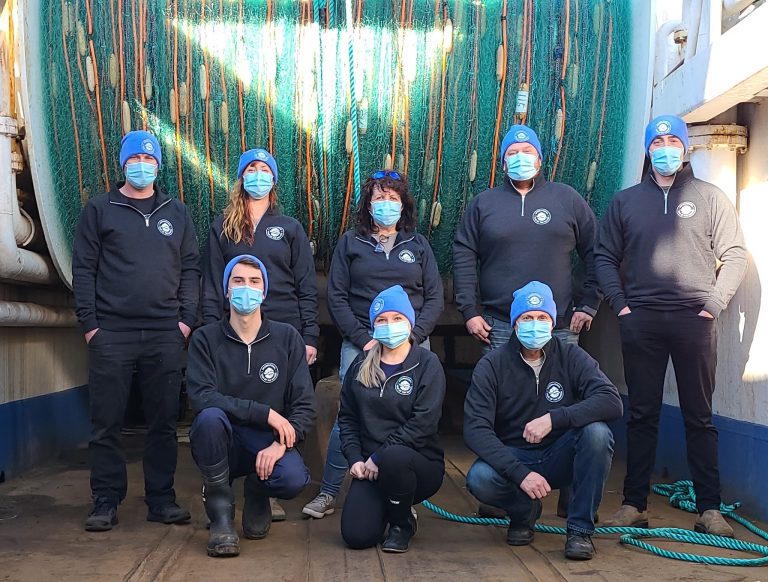
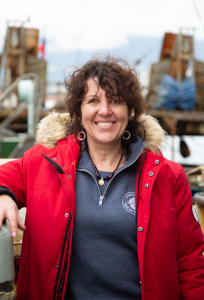 Chrys Neville is a research biologist and the Head of the Salmon Marine Interactions Program in the Regional Ecosystem Effects on Fish & Fisheries Section, Ecosystem Science Division at the Pacific Biological Station in Nanaimo, British Columbia. Chrys has over 25 years of experience leading field research programs studying the marine ecology of juvenile Pacific salmon. She has published and presented numerous papers on salmon ecology and the effects of climate on regional ecosystems and residency of juvenile salmon. Chrys became a biologist due to her love of the outdoors, nature and adventure. She joined the expedition for these reasons and the ability to learn something new about species that she has studied for many years. She comments that over the past 25 years there have been many changes and new approaches developed in fisheries research but the one thing that is unchanged is the necessity to actually go in the field and see first hand what is happening . “The changes that continuously occur between seasons, years or regions always amaze me and without being in the field and observing first hand, many of the subtle changes or shifts would be missed,” she says, “yet these changes may be the best clues to understanding the declines or shifts in salmon productivity”. Chrys will be the chief scientist on this vessel.
Chrys Neville is a research biologist and the Head of the Salmon Marine Interactions Program in the Regional Ecosystem Effects on Fish & Fisheries Section, Ecosystem Science Division at the Pacific Biological Station in Nanaimo, British Columbia. Chrys has over 25 years of experience leading field research programs studying the marine ecology of juvenile Pacific salmon. She has published and presented numerous papers on salmon ecology and the effects of climate on regional ecosystems and residency of juvenile salmon. Chrys became a biologist due to her love of the outdoors, nature and adventure. She joined the expedition for these reasons and the ability to learn something new about species that she has studied for many years. She comments that over the past 25 years there have been many changes and new approaches developed in fisheries research but the one thing that is unchanged is the necessity to actually go in the field and see first hand what is happening . “The changes that continuously occur between seasons, years or regions always amaze me and without being in the field and observing first hand, many of the subtle changes or shifts would be missed,” she says, “yet these changes may be the best clues to understanding the declines or shifts in salmon productivity”. Chrys will be the chief scientist on this vessel.
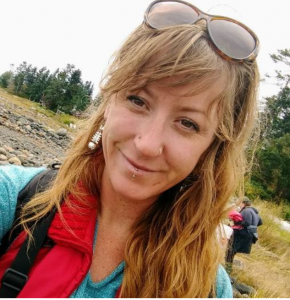
Rebecca is a research technician and expedition planner with the Pacific Salmon Foundation. She hails from the Ottawa Valley in Ontario and moved her way across Canada finally landing on Vancouver Island in 2004. The natural beauty and ecological diversity of the island paradise captured her heart, and she has since spent many years on the island working, exploring and studying Anthropology, Carpentry, Resource Management, and more recently Pacific salmon ecology in her various positions as a technician. Her passion for understanding and nurturing the environment extends beyond the aquatic world to the trees, skies, and coastal shorelines where she studies birds and volunteers on projects including migration monitoring at the Vancouver Island University Banding Station conducting point-count surveys of Western screech-owls and Western sandpiper migration research. She is also an avid volunteer with environmental clean-ups, restoration, and education. Rebecca’s work and studies have led to an adventurous resume conducting ethnographic research in Macedonia, doing carpentry work in Spain and western Canada, and she has worked on various projects for both the South Coast and Yukon Transboundary Stock Assessment Divisions of Fisheries and Oceans Canada. Her favorite part of her job is the amazing opportunities to conduct field work in remote locations including snorkeling with Pacific salmon, aerial surveys, and of course, at sea expeditions! Rebecca plans to continue with her career in the sciences and purse post-graduate studies in Environmental Anthropology where she would like to explore the role of local and traditional ecological knowledge in our current resource management systems. She hopes to employ ethnographic research methods to collect critical qualitive data and oral history that can improve the understanding of past, present and future ecological conditions in the coastal marine and freshwater systems.
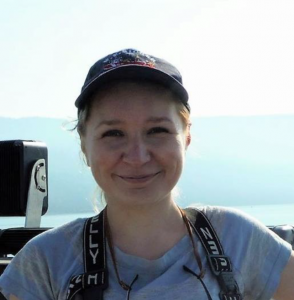
Svetlana Esenkulova is a marine biologist with the Pacific Salmon Foundation. For the last ten years she has been studying plankton dynamics in the Strait of Georgia. Svetlana participated in the Gulf of Alaska winter expeditions of 2019 and 2020 and is looking forward to 2022 Pan-Pacific Expedition. During this survey she will be focused on squid and the eDNA component.
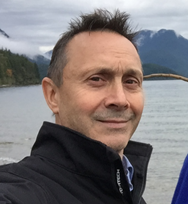 Dan is a former research biologist with Fisheries and Oceans Canada where he studied Pacific salmon and marine fish production trends in relation to climate change, and has additional fisheries research experience in Newfoundland, Labrador, Nova Scotia, and James Bay.
Dan is a former research biologist with Fisheries and Oceans Canada where he studied Pacific salmon and marine fish production trends in relation to climate change, and has additional fisheries research experience in Newfoundland, Labrador, Nova Scotia, and James Bay.
His graduate studies were in oceanography and marine fish population dynamics with a specialty focus on commercially-exploited clupeoid populations. Dan has experience as a commercial salmon fisher and also foreign fishery observer for Canada working off of the BC coast, and has significant experience working as the senior environment leader for heavy industry. He is currently on the board of governors of the Ocean Wise Conservation Association.
Dan’s current science interests are in the competitive interaction of human exploitation of global resources and the real-time and evolutionary consequence to shifting species habitat. He is actively engaged in the global biodiversity achievement dialogue. Dan jumped at the chance to volunteer for the 2022 Expedition and to support the effort to better understand the oceanic life history of salmon.
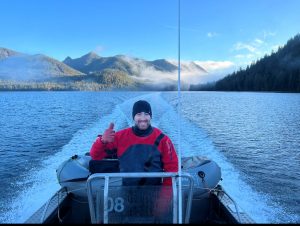 Geoffrey was born and raised on Haida Gwaii. He is a member of the Haida Nation and part of the T’aanuu Wolf/Raven clan. From a young age he has chased his passion for salmon and other food fish, shaping his childhood and focusing his professional career. He graduated from the University of Victoria with a B.Sc. in Economics where he spent a semester at home studying Natural Resource Science through the Haida Gwaii Institute. He is currently working for Parks Canada supporting Marine Planning Initiatives and co-management within Gwaii Haanas National Park Reserve, National Marine Conservation Area Reserve and Haida Heritage Site. Geoffrey has a keen interest in cultural, commercial and recreational fisheries that occur in the waters surrounding Haida Gwaii. As part of the 2022 International Year of the Salmon Expedition Geoffrey is keen to understand more about the years salmon spend at sea before starting their migration back to their natal streams. Moving forward he is hopeful that a deeper understanding of salmon will allow future generations the opportunity to have salmon impact their lives like it did his.
Geoffrey was born and raised on Haida Gwaii. He is a member of the Haida Nation and part of the T’aanuu Wolf/Raven clan. From a young age he has chased his passion for salmon and other food fish, shaping his childhood and focusing his professional career. He graduated from the University of Victoria with a B.Sc. in Economics where he spent a semester at home studying Natural Resource Science through the Haida Gwaii Institute. He is currently working for Parks Canada supporting Marine Planning Initiatives and co-management within Gwaii Haanas National Park Reserve, National Marine Conservation Area Reserve and Haida Heritage Site. Geoffrey has a keen interest in cultural, commercial and recreational fisheries that occur in the waters surrounding Haida Gwaii. As part of the 2022 International Year of the Salmon Expedition Geoffrey is keen to understand more about the years salmon spend at sea before starting their migration back to their natal streams. Moving forward he is hopeful that a deeper understanding of salmon will allow future generations the opportunity to have salmon impact their lives like it did his.
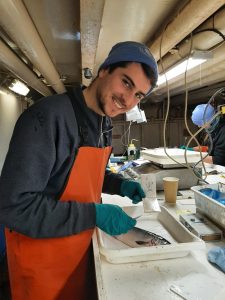 Aidan is the International Year of the Salmon (IYS) Coordinator for the North Pacific Anadromous Fish Commission. His role involves coordinating the IYS Data Mobilization and Likely Suspects Framework Signature Projects with partners from across the Northern Hemisphere as well as supporting the NPAFC Working Group on Stock Assessment and assisting with the coordination of the IYS 2022 Pan-Pacific Winter High Seas Expedition and related activities. Aidan has a Bachelor of Science and Masters of Biological Science, specializing in marine biology, from the University of Western Australia and completed an exchange semester at the University of Ottawa. Aidan’s work experience has ranged from environmental and marine science consulting roles, including marine turtle monitoring, work as a Research Assistant with the Western Australian Department of Fisheries and marine science education at the Bamfield Marine Sciences Centre, Canada. Aidan is very excited to participate in the Raw Spirit leg of the 2022 Expedition to be directly involved with the research that is being undertaken through the IYS High Seas Expeditions, to compare results with the 2019 and 2020 Expeditions and to be part of a historic and adventurous journey!
Aidan is the International Year of the Salmon (IYS) Coordinator for the North Pacific Anadromous Fish Commission. His role involves coordinating the IYS Data Mobilization and Likely Suspects Framework Signature Projects with partners from across the Northern Hemisphere as well as supporting the NPAFC Working Group on Stock Assessment and assisting with the coordination of the IYS 2022 Pan-Pacific Winter High Seas Expedition and related activities. Aidan has a Bachelor of Science and Masters of Biological Science, specializing in marine biology, from the University of Western Australia and completed an exchange semester at the University of Ottawa. Aidan’s work experience has ranged from environmental and marine science consulting roles, including marine turtle monitoring, work as a Research Assistant with the Western Australian Department of Fisheries and marine science education at the Bamfield Marine Sciences Centre, Canada. Aidan is very excited to participate in the Raw Spirit leg of the 2022 Expedition to be directly involved with the research that is being undertaken through the IYS High Seas Expeditions, to compare results with the 2019 and 2020 Expeditions and to be part of a historic and adventurous journey!
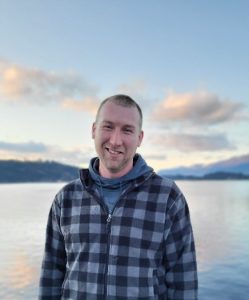 Brenden Lewis hails from Campbell River where he lives with his wife, Amanda and their two dogs. He has a lifetime of experience in the coastal waters of Vancouver Island where he began fishing with his family as a child. He is a third-generation commercial fishermen that grew up working on his father’s boat and still fishes with him today. Brenden has a range of experience longlining halibut around Haida Gwaii, gillnetting herring, trolling for sockeye salmon in the Johnstone Straits, prawning, and fishing offshore for tuna.
Brenden Lewis hails from Campbell River where he lives with his wife, Amanda and their two dogs. He has a lifetime of experience in the coastal waters of Vancouver Island where he began fishing with his family as a child. He is a third-generation commercial fishermen that grew up working on his father’s boat and still fishes with him today. Brenden has a range of experience longlining halibut around Haida Gwaii, gillnetting herring, trolling for sockeye salmon in the Johnstone Straits, prawning, and fishing offshore for tuna.
Brenden was eagerly recruited by Mike Banks, his fishing partner, after Mike joined the team. He didn’t bat an eye at the opportunity to head to the high seas and join an adventurous research team. He is contributing critical knowledge of longline and gillnetting methods to the expedition. Brenden’s hope for the expedition is that this research will help to improve our ability to manage and conserve Pacific salmon so future generations can enjoy them like he has.
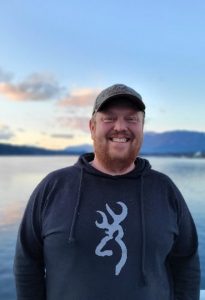 Mike Banks is a first-generation commercial fisherman and captain with over 20 years’ experience fishing on the Pacific Ocean. He is a father of three and is the owner and operator of a busy fishing business that he and his partner, Ashley, manage year-round. Mike is bringing extensive fishing experience and knowledge of the marine environment to the 2022 Expedition. His background includes trolling for salmon and tuna, longlining for halibut, gillnetting for herring, and has also worked as a deckhand on prawn vessels. He has fished all over Vancouver Island, the central and north Coast and in offshore waters. Mike has been an integral part of planning, fabrication and assembling of the longline fishing gear and he is very excited to join the team and contribute to research focused on improving our knowledge of salmon ecology. He hopes to teach his children and future grandchildren to fish and pass on sustainable fishing practices for generations to come.
Mike Banks is a first-generation commercial fisherman and captain with over 20 years’ experience fishing on the Pacific Ocean. He is a father of three and is the owner and operator of a busy fishing business that he and his partner, Ashley, manage year-round. Mike is bringing extensive fishing experience and knowledge of the marine environment to the 2022 Expedition. His background includes trolling for salmon and tuna, longlining for halibut, gillnetting for herring, and has also worked as a deckhand on prawn vessels. He has fished all over Vancouver Island, the central and north Coast and in offshore waters. Mike has been an integral part of planning, fabrication and assembling of the longline fishing gear and he is very excited to join the team and contribute to research focused on improving our knowledge of salmon ecology. He hopes to teach his children and future grandchildren to fish and pass on sustainable fishing practices for generations to come.
How do we Prevent Losing a Gillnet at Sea?
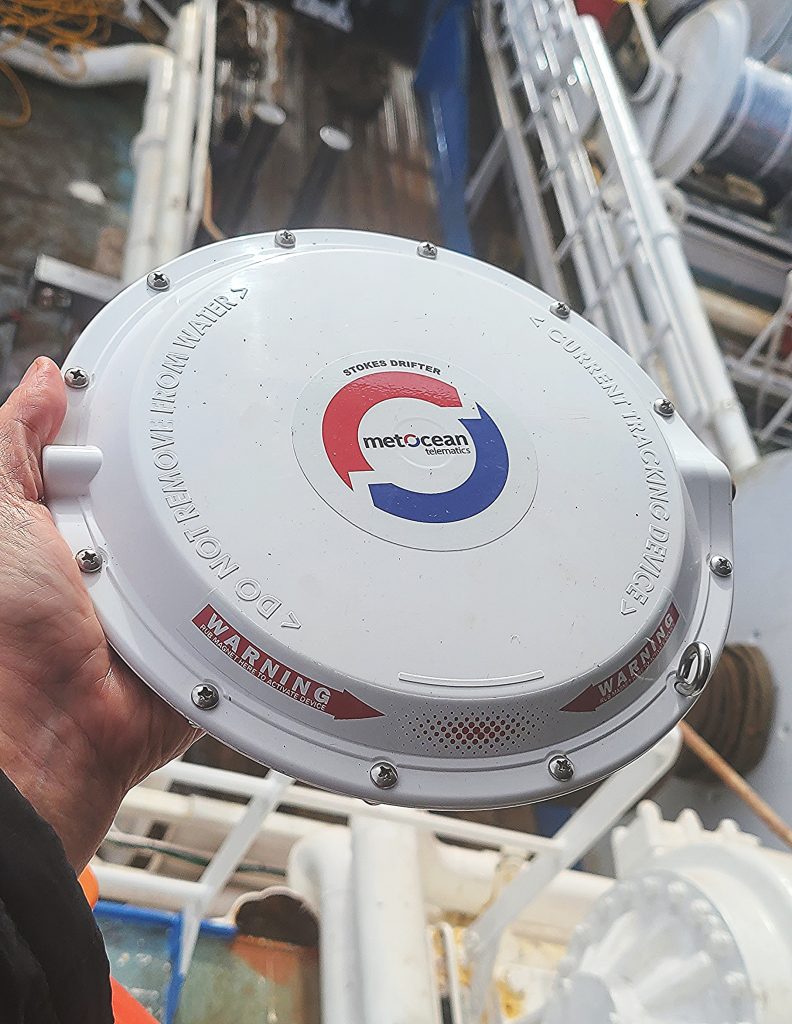
The application of gillnets to study Pacific salmon in the ocean is not new but is seldom used today due to concerns about bi-catch and ghost nets (nets lost at sea that could still be fishing). Gillnets are being used in this study to provide an independent sampling gear to compare with catches collected by surface trawl nets being used by the other IYS participants; and to enable comparisons with past research in the North Pacific. But how are we addressing concerns for bi-catch and the possibility of losing a net?
A Canadian innovation, provided by MetOcean Telematics (Dartmouth, Nova Scotia), is being used to minimize any risk of losing a net (the STOKES drifter buoy (photo)). Drifters are attached to each end of each net to monitor its drift while fishing and to ensure that the ship can locate the drifter within meters via satellite communications and GPS positioning. This tool also provides tracks of the net while it fishes and samples surface temperatures simultaneously. Bi-catch is more difficult to address but is limited by using just two nets of shorter length and limiting fishing times. All bi-catch will be included in reports from this research.
The small light-weight STOKES drifter is equipped with Iridium satellite telemetry, GPS positioning, and a sea surface temperature sensor. Iridium is a communication system using the Iridium satellite constellation, a system of 66 active satellites used for worldwide voice and data communication provided by Iridium Communications Inc. Iridium allows the buoy to have bi-directional capabilities … for example, if the buoy enters a region of interest the end-user can communicate with a unit by sending it a command to change reporting intervals or request essential time sensitive data.
MetOcean Telematics corporate headquarters, including the research and development and production facilities, are located in Dartmouth, Nova Scotia, Canada. For additional information about MetOcean Telematics or any of its products, please contact sales@metocean.com.
Raw Spirit Survey Details
Departure from Port Alberni BC – February 23, 2022
Transit to Zone 5 and conduct first leg of integrated oceanographic and gillnet survey – February 23 to March 5, 2022
Stop in location that is still to be determined halfway through for resupply– March 6-7, 2022
Transit to Zone 5 and conduct second leg of integrated survey—– March 8 to March 20, 2022
Return to Port Alberni BC – March 22, 2022
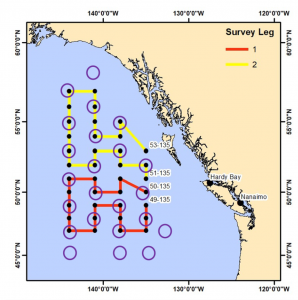 The survey area will be in the Gulf of Alaska and generally in the survey area of the Canadian vessel CCGS Sir John Franklin (Figure 1 – purple circles mark the Raw Spirit stations). The survey will start from Port Alberni on February 23 and continue for about four weeks with a refueling port stop in the middle. Sampling stations also depend on weather. The gillnet sampling locations outside of the zone 5 trawl zone are based on experiences in 2019 and 2020 and are specifically to assess pink salmon in southern areas and sockeye salmon in the north. All catch (fish and other) will be recorded and reported.
The survey area will be in the Gulf of Alaska and generally in the survey area of the Canadian vessel CCGS Sir John Franklin (Figure 1 – purple circles mark the Raw Spirit stations). The survey will start from Port Alberni on February 23 and continue for about four weeks with a refueling port stop in the middle. Sampling stations also depend on weather. The gillnet sampling locations outside of the zone 5 trawl zone are based on experiences in 2019 and 2020 and are specifically to assess pink salmon in southern areas and sockeye salmon in the north. All catch (fish and other) will be recorded and reported.
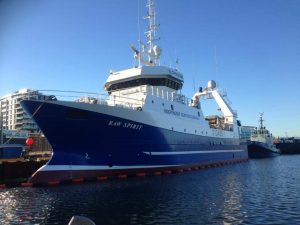
Name: Raw Spirit
Gross Tonnage: 672
Length (m): 43
Maximum Speed: 12.3 knots
Year Launched: 1998
Home Port: Port Alberni, British Columbia
Flag: Canada
Scientific Equipment on Board
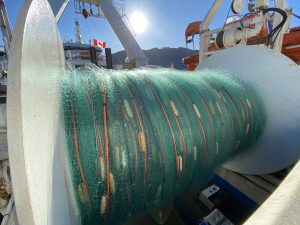 Standard research gillnets consist of variable mesh-sizes (C-gear: 3 tans each of 48, 55, 63, 72, 82, 93, 106, 121, 138, and 157 mm) combined with panels of ‘commercial’ gillnets (A-gear: 19 tans of 115 mm mesh size). One tan is 50 m long, and then the total gillnet length is 2,450 m, which is within regulation. Three sets of gillnets have been manufactured by the Nichimo Company, in Tokyo, Japan.
Standard research gillnets consist of variable mesh-sizes (C-gear: 3 tans each of 48, 55, 63, 72, 82, 93, 106, 121, 138, and 157 mm) combined with panels of ‘commercial’ gillnets (A-gear: 19 tans of 115 mm mesh size). One tan is 50 m long, and then the total gillnet length is 2,450 m, which is within regulation. Three sets of gillnets have been manufactured by the Nichimo Company, in Tokyo, Japan.
The depth of gillnets is about 7 m when fully extended but the depth of fishing will vary with the currents experienced. The effective depth of fishing may be 2.5 m to 4 m and will be measured routinely using RBR depth meters (recording temperature and depth of the lead line).
Two gillnets will be set per night from dusk to approximately midnight (0:00 hr). Catch will be recorded by panel/mesh size in each net. Each net will have an AIS transponder and lights attached to ensure the vessel can track each net.
Thank you to our partners!
